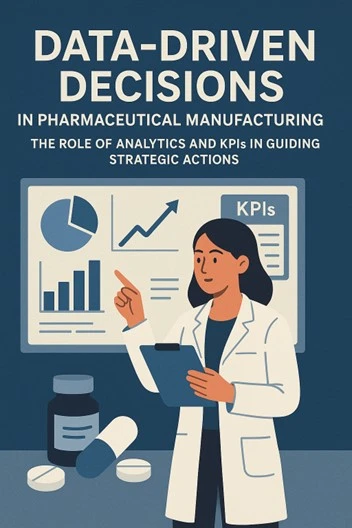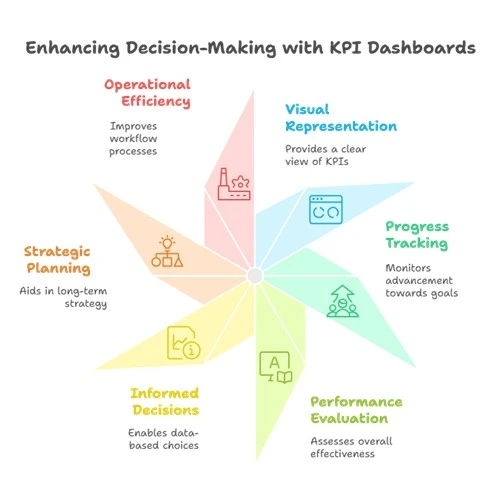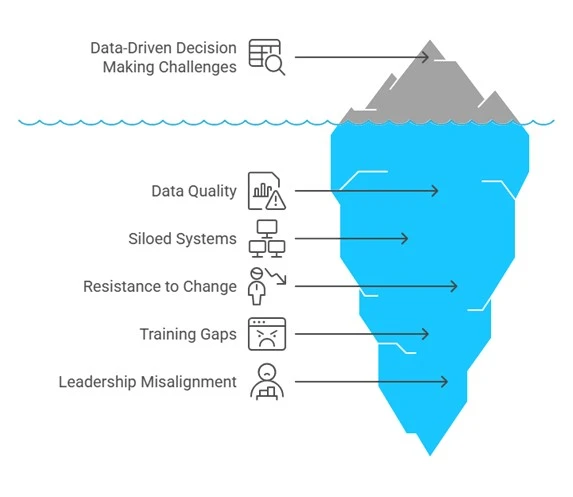Introduction
In today’s competitive pharmaceutical industry, making informed decisions based on robust data is not an advantage; it is a necessity. As pharmaceutical manufacturing operations grow increasingly complex, the role of data-driven decision making becomes even more critical in ensuring product quality, minimizing costs, enhancing productivity, and maintaining regulatory compliance. This article explores how analytics and Key Performance Indicators (KPIs) are transforming pharmaceutical manufacturing. We’ll look into the principles of data-driven decision making, its significance in operational excellence, and how pharma companies can leverage analytics to streamline processes, predict issues, and make proactive decisions. The article also discusses the challenges and best practices in implementing a data-driven culture.
This article explores how analytics and Key Performance Indicators (KPIs) are transforming pharmaceutical manufacturing. We’ll look into the principles of data-driven decision making, its significance in operational excellence, and how pharma companies can leverage analytics to streamline processes, predict issues, and make proactive decisions. The article also discusses the challenges and best practices in implementing a data-driven culture.

Understanding Data-Driven Decision-Making
Data-driven decision making is the practice of basing decisions on data analysis rather than intuition or observation alone. It involves collecting relevant data, analyzing it for trends and insights, and using the findings to guide strategic and operational decisions. In the pharmaceutical industry, this practice is critical for ensuring that every step, starting from raw material sourcing to final product release, meets the highest standards of quality and compliance.
Key Elements of Data-Driven Decision Making
- Data Collection: Collecting data from different sources such as manufacturing equipment, Laboratory Information Management Systems (LIMS), Batch Records, and Enterprise Resource Planning (ERP) systems.
- Data Integration: Gather all the data in a unified system or platform for easier access and analysis.
- Analytics Tools: Utilizing software and algorithms to convert the raw data into insights.
- Data Visualization: Presenting data in an understandable and actionable format, such as dashboards.
- Decision-Making Frameworks: Establish criteria and workflows that use data analytics to generate action plans.

Analytics in the Pharma Industry
Analytics allow manufacturers to move from reactive to proactive decision-making. They help in identifying inefficiencies, predicting potential failures, and optimizing resource utilization.
1. Predictive Analytics
Predictive analytics uses historical data and inferential statistics to generate predictions and conclusions regarding future events.
- Predict equipment failures and schedule preventive maintenance.
- Forecast demand and optimize inventory levels.
- Anticipate deviations in products.
2. Prescriptive Analytics
Prescriptive analytics goes a step further by recommending specific actions.
- Suggest optimal process parameters for better yield.
- Recommend training for operators based on performance trends.
- Identify cost-saving opportunities in supply chain logistics.
3. Real-Time Analytics
With Industry 4.0 technologies, real-time analytics has become achievable. Internet of Things (IoT)-enabled sensors and SCADA systems provide instant feedback on critical process variables, enabling immediate corrective actions.
You can learn about SCADA systems in the link below:
https://www.techtarget.com/whatis/definition/SCADA-supervisory-control-and-data-acquisition

Role of KPIs in Driving Performance
KPIs are quantifiable metrics that reflect the performance of manufacturing operations. They serve as benchmarks and guides in decision-making.
1. Categories of KPIs
- Quality KPIs: Deviation Rate, Out-of-Specification (OOS) Incidents.
- Production KPIs: Overall Equipment Effectiveness (OEE), Cycle Time, Yield%, Equipment Down Time.
- Compliance KPIs: CAPA Closure Time, Training Efficiency, Number of Safety Incidents per Month/Department.
- Cost KPIs: Waste Percentage, Energy Consumption, Operating Expenses (OPEX).
- Supply Chain KPIs: Inventory Turnover, Order-to-Delivery Time.
2. KPI Dashboards
KPI dashboards enable real-time monitoring and help managers quickly identify deviations and take corrective actions.

Implementing a Data-Driven Culture:
Creating a data-driven culture requires more than just technology. It demands a cultural shift within the organization.
Leadership Commitment
A data-driven culture starts at the top. Leaders must champion the use of data in decision-making, not just talk about it. They need to show through their actions that data matters. When a senior leader asks for data to back up project proposals or uses dashboards in meetings, it sends a clear message across the organization: decisions must be informed, not assumed, or by intuition.
It’s a matter of inspiration, not enforcement. “True leaders help teams see the value, not the obligation”.
Data Access and Governance
One of the biggest barriers to a data-driven culture is that employees either can’t access the data they need or can’t make sense of it when they do. To overcome this, organizations must break down the data and make the key metrics available in a user-friendly format, such as Dashboards and interactive real-time KPIs. A well-structured visual dashboard is far more motivating and usable than a spreadsheet or data collected in an ERP window. Organizations must have policies and procedures on how to give the right people access to the right data at the right time.
Training and Culture Change Management
You can have the best tools in the world to collect and generate analytics, but if your team doesn’t understand how to interpret the data, it won’t matter. All organizations must have the ability to think in data. That means training to establish data literacy and mentoring to inspire people to change.
Managers must create spaces where people feel comfortable asking questions about metrics or challenging any assumptions. Encourage curiosity, not just compliance. It’s also helpful to train team members on how to tell stories with data. When people connect the metrics to outcomes, they become powerful and memorable.
Data shouldn’t be something people check once a month. It should be embedded in daily operations, morning huddles, shift handovers, quality reviews, and project updates. When data becomes part of the daily rhythm, it becomes second nature. That also means making it actionable. A dashboard that shows you’re behind schedule but doesn’t suggest why or what to do next isn’t very helpful. Aim for systems that guide decisions, not just display stats.
Celebrate when a team uses data to solve a problem or improve a process. Recognize individuals who challenge assumptions using evidence. And when something goes wrong, resist the urge to blame. Instead, use the data to understand what happened, why, and how to prevent it. This fosters a psychologically safe environment where people feel empowered to be transparent and proactive.
Challenges in Adopting Data-Driven Decision Making:
Shifting to a data-driven mindset is not without its hurdles.
1. Quality of Data:
Teams often find themselves working with inconsistent, incomplete, or outdated data. When people can’t trust the numbers, they hesitate to use them, which leads to flawed decisions.
2. Siloed systems:
Data scattered across multiple sources and systems makes it difficult to get a clear picture.
3. Resistance to change:
For employees who’ve relied on experience and instinct for years, shifting to data can feel like losing control. If the cultural shift isn’t handled with empathy and good communication, it leads to chaos.
4. Training gaps:
Not everyone is comfortable interpreting charts or using analytical tools. Without proper support, employees may feel overwhelmed, even excluded.
5. Leadership alignment:
If leaders push for data use but still rely on gut instinct themselves, it sends mixed signals. People follow what leaders do, not just what they say.

Practices for a successful shift towards a Data-Driven organization:
Start Small
Pilot projects can demonstrate the value, train the organization, and build momentum.
Cross-Functional Collaboration
Involve stakeholders from various departments to ensure diverse perspectives and alignment.
Continuous Monitoring and Improvement
Implement the PDCA cycle to improve over time. Unlock deeper insights into the PDCA cycle
External Expertise
Benchmarking and consulting technology partners can provide valuable insights and accelerate implementation.
Conclusion:
The future of pharma industry lies in intelligent, data-driven operations. By embracing analytics and KPIs, organizations can move beyond reactive decision-making to proactive, strategic action. This not only enhances product quality and operational efficiency but also ensures better compliance and patient safety. However, the journey requires strong leadership, a cultural shift, and investment in the right tools and talent. As the industry continues to evolve, those who successfully harness the power of data will lead the way in innovation and performance.

